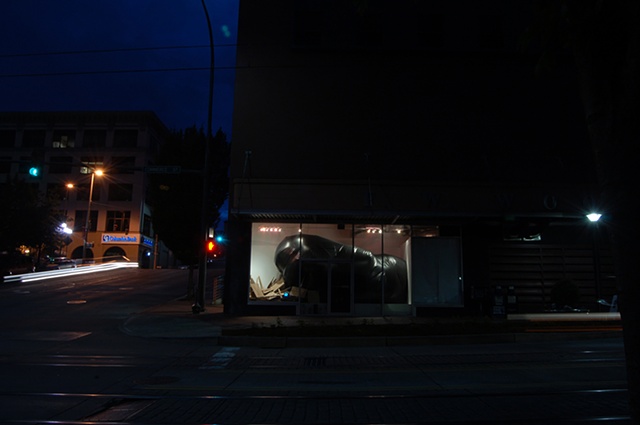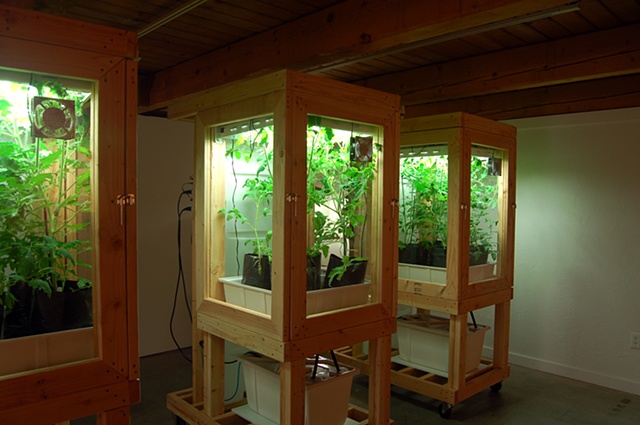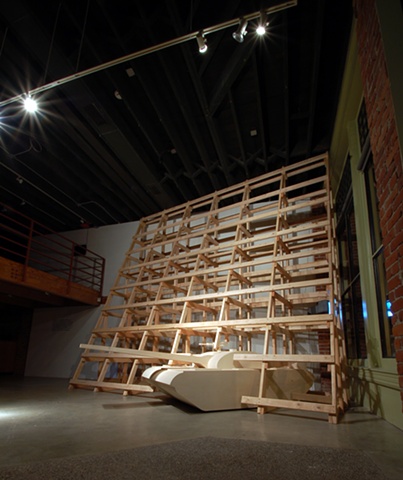From January 21 to April 8th, the UO art faculty members will be showing their work in The Long Now, an exhibition at the Jordan Schnitzer Museum of Artfrom January 20 to April 8 in Eugene. Selected works by six art faculty members will be shown at the White Box in Portland from January 24 to March 24. To highlight the artists behind the art, I’m having conversations with several of the faculty in the show to hear more about their practice.
My first conversation is with Brian Gillis, a multidisciplinary artist whose practice examines relevant socio-cultural issues that may have fallen on deaf ears, been buried over time, or simply obscured by something else. He is interested in history as both an archive and a mine, as that which can at once chronicle and act as a catalyst for the reconsideration of one’s world. His work is discursive, research based, and uses a variety of production strategies ranging from observation and representation, to comment and action.
Gillis is the recipient of numerous awards, including an Illinois Arts Council Individual Artist Grant, Bronze Prize at the Art Interview 23rd International Artist Competition, Berlin, Germany, a Brink Award Nomination, and a Merit Fellowship at the Contemporary Artists Center, NY. He has exhibited nationally and internationally, including recent solo exhibitions at the Abraham Lincoln Museum, IL, Tacoma Contemporary, WA, and the Urban Institute for Contemporary Arts, MI, with an upcoming exhibition at CUE Art Foundation, NY.
The interview below has been edited for clarity and length.
Dave Amos, A&AA writer: Your work focuses on the hidden and obscure in society. Why is that interesting to you?
Brian Gillis: The most interesting thing about it is when you find something that might be hidden in plain sight or something that’s obscured by something else. That ‘aha’ or discovery leads to a reevaluation of your world, or who you are, or who the people around you are. That helps set up a real or implied discussion about who you are and who you want to be, and what you want your world to be. A lot of this comes from who I am as a person. My entire life I’ve been interested in the history of marginalized people or cultures and learning about inequities, in large part, I think, because of the potential a response has to balance them.
DA: Sometimes the meaning of your work is more obvious to me, but in others it seems more like a puzzle. Is the meaning always consistent in your work?
BG: I’d like to think many of the objectives of the work are consistent but I think the mechanics of how to get there are varied. The devices I use most commonly are to put things next to each other and through their juxtaposition they communicate a question. And, if the viewer articulates the questions to themselves, it could lead to further investigation.
 DA: All of your pieces use their space well. Do you have the space in mind when you create your pieces?
DA: All of your pieces use their space well. Do you have the space in mind when you create your pieces?
BG: More often than not, I try to use the site as one of the components. Recently I built a piece called “Now!” at Tacoma Contemporary (above), which is in this old Woolworth’s building in this area of Tacoma that packed with banks; it’s a financial district. So, I thought it was appropriate to make a piece about people resisting aristocratic domination. It’s really important for me not only formally to take the space into account but conceptually as well.

DA: What’s the story behind the hydroponics piece (above)?
BG: My objective was to use the gallery as a laboratory to try to understand what role disobedience may have played in the development of humans. The whole project was based on the question ‘what is disobedience?’ I thought of the whole space as one piece; the tank piece was one part, the safe cracker was another part, et cetera. With the hydroponics element, I was thinking ‘What is disobedience in science?’ Perhaps it’s the activity of simulating sun, or simulating soil, or nutrients, or choosing specific genetics for certain yields.
DA: Your pieces use a variety of materials. How are they chosen for a piece?
BG: Materiality is very important to me. I really feel like the materials in and of themselves are as big a part of telling the story as an image or an object. For instance, if using ceramics, it could get at fragility, permanence, or it could also reference cultures, et cetera. whereas using frozen beef livers could get at a host of other things. I pay a lot of attention to what these materials are; I really want the materials to contribute conceptually, to exist out of necessity. I really feel privileged by the times that I’ve come up in as an artist, where we have permission to use whatever material is necessary.
DA: Do you have influences?
BG: I do have influences that come from art and other artists, but I would say my greatest influences come from outside the discipline. For instance, Zora Neale Hurston is one of my greatest influences. She was a writer who became popular with the Harlem Renaissance. She was not only a poet and a writer, but also an anthropologist at a time when anthropology was new, and women and African Americans really weren’t doing it. She was a polymath. I think of these old 18th and 19th century ‘learned gentlemen’, men of wonder, the first scientists, who were basically these rich dudes who were in a position to investigate things in the world. You might have a guy who is an astronomer but there was no discipline of astronomy so he ends up being a musician, mathematician, telescope maker, and astronomer. My greatest influences are these people who come at things from multiple perspectives and develop a background through training and inquiry in a bunch of different areas.
DA: Do you know what piece you’ll be exhibiting at the faculty art show?
BG: I’m still not sure. One of the things I love about being an artist is the permission I have to constantly be redesigning who I am and my approach to things. For the past 5-7 years the majority of my work has been these solo projects focused on the relationship in space between these pieces in the show. A group show is problematic in this regard. For group shows I’ve been sending away parts for things that carry with them the context of the bigger thing, but I always kind of feel like they fail to get at the original context completely.
This group show is interesting and exciting for a bunch of different reasons. One is that my colleagues and I all have different practices, and I really respect them a lot and we seldom have time to talk about our work. It’s also being curated by an outside person who I respect a lot. What we’re all really excited about is how this outside person who is unbiased can draw threads between who we are. I want it to be new work, and I have a couple of things on deck that could go in there, but I really don’t know yet. I must say I’m a little intimidated by it. When you have the space to yourself, you can create a context. If my piece is next to somebody’s piece that’s a video about war, and my piece happen to have a layer about conflict, inevitably they’ll play off each other.
I think one nice thing about this group show being based on our connection to an institution and not a theme in the work, is that the audience will understand that these are individuals that have very disparate practices, so maybe they won’t link the work together as much. I’m excited about these problems.
DA: How do you work through ideas?
BG: I have a system where I’m constantly generating new ideas, developing ideas previously generated into something to act upon, and acting upon something. I have a sketchbook that I always carry with me and whenever I think of a new idea I start a new page. I’ll take some notes and I’ll pour resources or more ideas into it as they come. Very often I’ll start a word document and work with it the same way. A lot of my work deals with history and social inequities, so a lot of it is very heavily researched. I’ll go the library, do web searches, talk to people, and use the word document as a receptacle. The form usually takes shape after this stage relative to the objectives I establish. Then it may be in a place where I can write a narrative about it. Once I have some objectives that work as a proposal, can then develop a proposal, and then I shop the proposal. Once I find a place in the world for the work, I make it. Sometimes, I just get an idea and make stuff.
DA: Much of your work feels like a monument or memorial to your subject. Is this an aspect that you think about when working on a piece?
BG: For the last 10 or 15 years I’ve been thinking a lot about monument and memorializing something. In the last four or five years I’ve become more suspicious of the gallery and whether it is the most appropriate context for my work because I want the work to be completely democratic, where anyone can access it. People like you and me might be the kind of people who go to an art gallery, but I want it to be something that’s really more widely available. I’ve been trying to shop projects I’ve developed for public spaces. I would like to see the work become more and more public, so it could take into account a specific context outside of a building defined for art.
A friend of mine’s family founded this town outside Palermo, Sicily around 900 years ago. It’s pretty amazing. I went there and they have this wall as a part of their property that has been there forever. It’s this place called Casteldaccia. In the late 19th century this pasta factory was established, and they eventually started manufacturing a majority of the pasta for Trader Joe’s. Now, even though everyone in this town has been there for like 900 years, because this pasta factory has gotten all of this acclaim in the States everyone thinks the factory’s founders founded the town. So, my friend’s mom has been working on this family tree to set the record straight.
In a lot of these towns in Europe, in the courtyards, you’ll often see a stone up on a building where the market was that have these different lengths or measurements engraved in them. You know, an inch is based on a part of a guy’s hand, etc. It would always be based on the aristocrat in town’s body. In this town, Castledaccia, there are these measurements from my friend’s ancestor but it is over looked in favor of believing that this currently successful factory family founded the town, so my friend’s mom is putting together their family tree to go up there publicly and lay claim as the founders. I’ve been talking with them about doing some sort of project about this.

I would love to do something that’s not only public but is also a necessary service to the place or community. Putting a monument in Tiananmen Square would be really great because it would keep Tank Man’s story alive forever, but I would like the work to provide a service that goes beyond a retrospective testament or memorial. I’ve been trying to develop things that are a retrospective testament but also locate an identity in a place; something that could be a little more relevant to who the people are in that place and perhaps something that lives through some sort of perpetual service beyond the identification of something that happened at a site long ago.
DA: How much of your work is inspired by being in Eugene? Is your influence all of where you’ve been?
BG: I’m sure I’m influenced by Eugene in some ways, and certainly all of where I’ve been make up who I am. But, I think the biggest thing is probably being attached to a research institution. I think it influences me and really contributes to my practice invaluably. Not just the resources of the libraries and the people, but the way I approach the work as an academic. As a historian, journalist, or scientist might in a lot of ways. I might develop a hypothesis and do research and experimentation, et cetera.
I think there is an ethos in the Pacific Northwest that supports social equity that is a big deal to me too. As I’ve become more suspicious of the gallery as the end context, I’ve been thinking a lot about what the value of the production of art is in society to begin with. I think of a lot of the work I’ve been doing as being rooted in observation, or representation, or comment. Since coming to Oregon, I’ve really been interested in having observation, representation, comment and action be a part of the work. It might exist in the gallery in one iteration, but then resonate outside in perhaps a different form. For instance the hydroponics piece we spoke about was a part of a larger piece focused on investigating what disobedience is, but were growing a crop of tomatoes in the gallery that were given to a food bank. Then, at the conclusion of the show, one of the three hydroponic cabinets was given to a science department at a high school by the gallery so they could continue to grow tomatoes for the food bank.
I’ve been more and more interested in the work being public in ways where an action can lead to service. Where it becomes more than just me in a privileged position commenting on something, but such that the comment is a point of departure for some action or service that then operates to further inform or define that comment and somehow completes a loop of sorts that makes all of its parts more relevant.
Photos courtesy of Brian Gillis.

